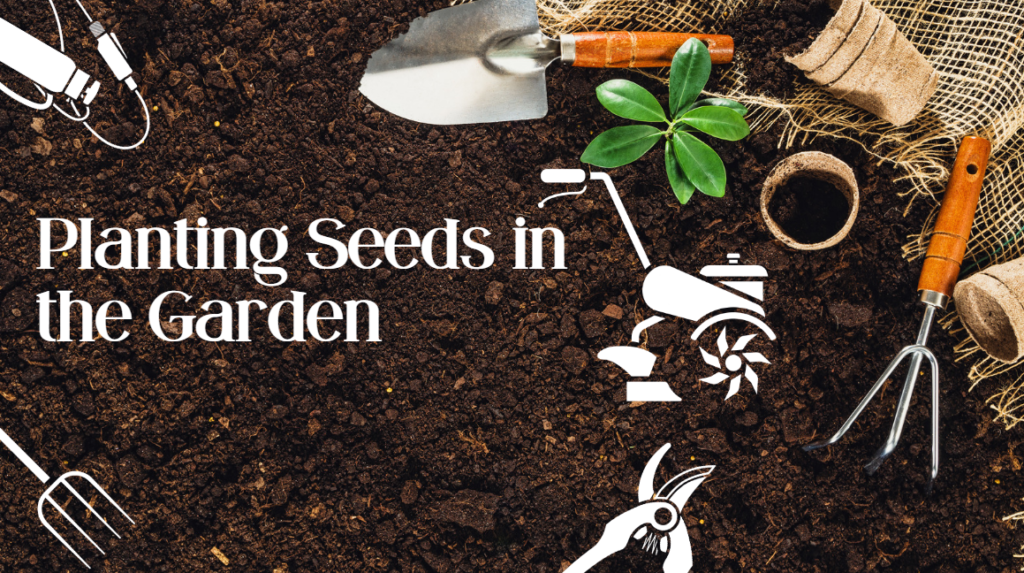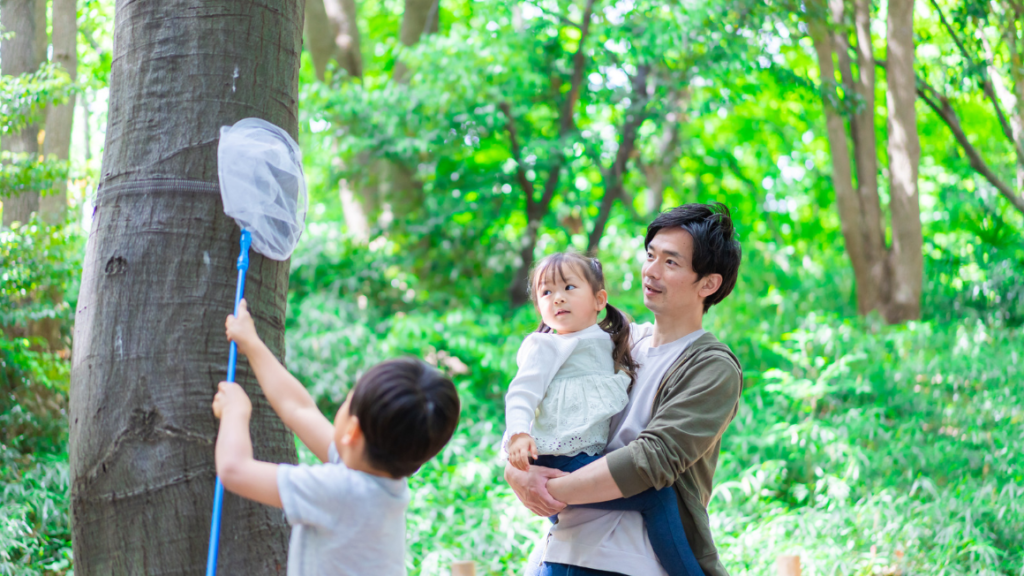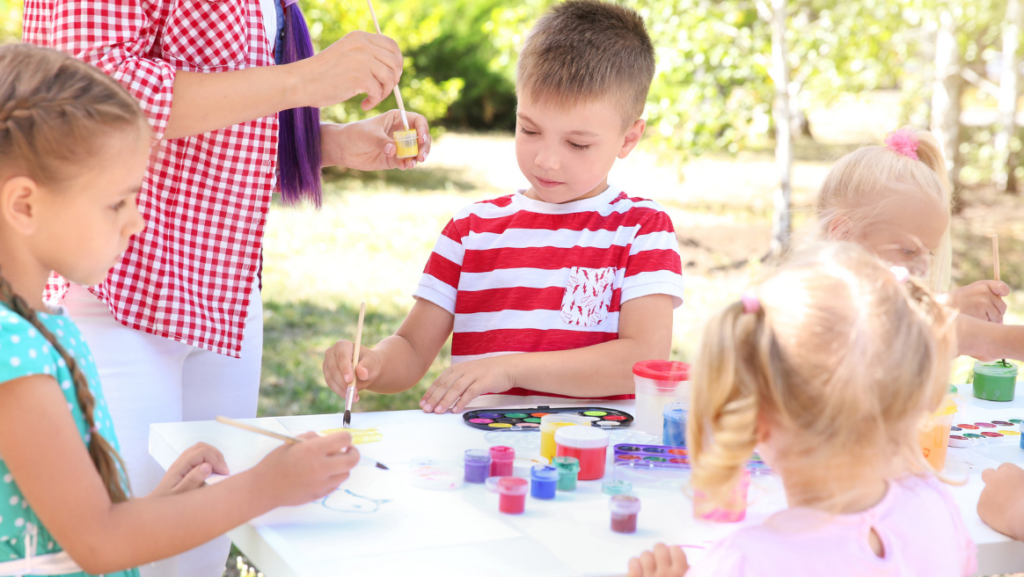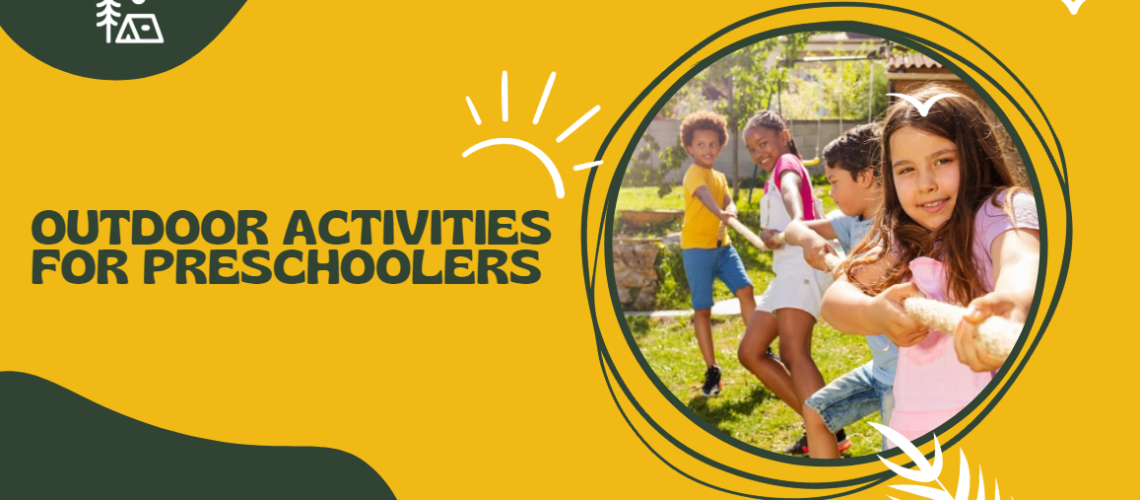Hey there! Have you heard of Montessori education? It’s a really cool way for kids to learn by exploring and discovering things on their own. And guess what? One of the most excellent parts of this approach is that it involves lots of fun outdoor activities! These activities help kids develop their cognitive, social, and motor skills, all while having fun and being creative.
So, we’ve put together a list of some great Montessori outdoor activities for preschoolers that will help them unleash their creativity and curiosity. Let’s check them out!
Benefits of Outdoor Activities for Preschoolers
Getting your preschooler outdoors and active can have numerous benefits. For one, outdoor activities can help enhance gross motor skills and improve physical abilities. Additionally, playing outside can stimulate young minds, promote creativity and curiosity. Lastly, spending time in nature can help children connect with the environment. Therefore, it would be wise to plan some fun outdoor activities with your preschooler today.
List of 10 Montessori Outdoor Activities for Preschoolers
Looking for some fun and educational outdoor activities to do with your preschooler? Check out these 10 Montessori-inspired ideas that are easy to set up and will provide hours of entertainment and learning opportunities.
1. Planting Seeds in the Garden

Encourage your little ones to explore the wonders of nature with the Montessori activity, “Planting Seeds in the Garden.” This hands-on experience allows children to cultivate their interest in nature and develop an understanding of life cycles and the importance of nurturing living things.
Materials Needed:
- Pot or planter
- Soil
- Seeds
- Watering can or spray bottle
What to Do:
- Fill the pot or planter with soil, leaving enough space for the seeds to grow.
- Create small holes or furrows in the soil, about 1 inch apart.
- Place the seeds in the holes, following the instructions on the seed packet for spacing and depth.
- Gently cover the seeds with soil and pat it down lightly.
- Water the soil thoroughly using a watering can or spray bottle.
- Find a sunny spot in the garden for the pot or planter.
- Encourage your child to water the seeds regularly, ensuring the soil remains moist.
- Observe and document the growth of the seeds, discussing the changes and developments with your child.
2. Nature Scavenger Hunt
Get ready for an exciting adventure as we explore the wonders of the great outdoors with this Montessori activity. This engaging outdoor scavenger hunt encourages children to explore their surroundings, appreciate the environment, and enhance their problem-solving skills.
Materials Needed:
- Scavenger hunt checklist (can be prepared in advance or use a printable template)
- Pencil or marker
- Optional: magnifying glass or binoculars
What to Do:
- Prepare a scavenger hunt checklist with a variety of nature-related items or clues for your child to find. Consider including leaves, flowers, rocks, feathers, or animal tracks.
- Give the checklist and a pencil or marker to your child.
- Head to a nearby park, garden, or nature trail and explain the scavenger hunt rules.
- Encourage your child to explore their surroundings and search for the items on the checklist.
- As your child finds each item, they can mark it off the list.
- If desired, encourage your child to use a magnifying glass or binoculars to observe nature more closely.
- Celebrate and discuss their findings once the scavenger hunt is complete.
3. Mud Kitchen

Engage your child’s senses and foster their creativity with this Montessori activity. The mud kitchen provides children with a sensory experience that promotes creativity, imaginative play, and thinking outside of the box.
Materials Needed:
- Outdoor space or designated area
- Table or elevated surface
- Pots, pans, and utensils
- Natural materials like sticks, leaves, and stones
- Water source
What to Do:
- Find an outdoor space or designate a specific area for the mud kitchen.
- Set up a table or elevated surface as the kitchen counter.
- Gather pots, pans, and utensils for your child to use in their mud kitchen.
- Collect natural materials like sticks, leaves, and stones as additional props.
- Provide a water source nearby for your child to use in their mud kitchen activities.
- Encourage your child to explore, mix, and create with the mud using utensils and natural materials.
- Let their imagination guide their play as they pretend to cook, bake, and create tasty mud dishes.
- Emphasize that getting messy and having fun with the sensory experience is okay.
4. Sensory Walks
Embark on a sensory adventure with your child through the activity of sensory walks. These walks involve exploring different surfaces to stimulate their senses, enhance motor skills, and promote a deeper connection with the world around them.
Materials Needed:
- Outdoor space or natural environment
- Various textured surfaces (grass, sand, gravel, wood, etc.)
- Optional: Blindfold or sensory items for additional sensory experiences
What to Do:
- Find an outdoor or natural environment where you can take a sensory walk.
- Set a path or designate different areas with various textured surfaces like grass, sand, gravel, or wood.
- Guide your child to walk barefoot, feeling the different textures with their feet.
- Encourage them to describe the sensation of each surface, such as the softness of grass or the roughness of gravel.
- For an added challenge, blindfold your child and have them rely on their other senses, like touch and sound.
- If desired, bring along sensory items like scented flowers, pinecones, or textured objects to engage their senses further.
- Discuss their sensory experiences and find joy in discovering new ways to interact with nature.
5. Sand Play

Explore the world of sand play with your preschooler, a delightful activity that promotes fine motor skills development and provides a captivating sensory experience.
Materials Needed:
- Play sand
- Sand toys (buckets, shovels, molds, etc.)
- Optional: Water, natural materials (shells, rocks, sticks)
What to Do:
- Find a suitable location, such as a sandbox or designated area with sufficient play sand.
- Provide your child with sand toys like buckets, shovels, and molds to encourage imaginative and creative play.
- Let your child explore the different properties of sand, feeling its texture, and experimenting with building structures and shapes.
- Encourage them to use their hands and fingers to manipulate the sand, building fine motor skills.
- If desired, add water to the sand for a different sensory experience and to facilitate building and molding.
- Introduce natural materials like shells, rocks, or sticks to incorporate additional sensory elements and spark creativity.
- Engage in the play alongside your child, fostering a connection and shared experience.
6. Water Play
Engage in the splashing and sensory experience of water play, a fun outdoor activity that promotes scientific understanding and enhances gross motor skills.
Materials Needed:
- Water source
- Water toys (sprinklers, buckets, water guns, etc.)
- Optional: Sponges, water beads, bubbles, food coloring
What to Do:
- Find an outdoor area with access to a water source, like a hose or sprinkler system.
- Provide your child with various water toys, like buckets, water guns, and sprinklers, that they can use to play with the water and experiment with spray and flow.
- Test out the forces of water with containers of various sizes and shapes, like measuring cups and funnels.
- Have your child feel the sensation of water on their skin and engage in water play with their entire body, running, jumping, and splashing around.
- Introduce different materials like sponges, water beads, or bubbles to add additional sensory elements or food coloring to demonstrate color mixing.
- Use the opportunity to introduce scientific concepts like the properties of water, gravity, and volume with simple explanations and demonstrations.
- Have fun and enjoy the cooling and playful experience of water play.
7. Outdoor Music Station

Create an engaging space for your child to explore the world of sound and rhythm with an outdoor music station, a fun activity that develops auditory skills.
Materials Needed:
- Recyclable materials (cans, bottles, cardboard tubes)
- Objects that make noise (bells, rattles, tambourines)
- Optional: Paint, stickers, markers
What to Do:
- Find an outdoor space where you can set up your music station.
- Collect recyclable materials, such as cans, bottles, and cardboard tubes that can be used to create various sound effects.
- Encourage your child to explore the different objects and experiment with the sounds they make, like bells, rattles, and tambourines.
- Allow your child to decorate and customize their instruments with paint, stickers, or markers, fostering creativity and personal expression.
- Emphasize the importance of rhythm and timing, providing opportunities for your child to practice clapping and tapping along to songs or beats.
- Join in on the fun and create music together, singing along to your favorite songs and letting your creativity shine.
- Discuss the different sounds and how they are made, providing basic explanations of sound waves and vibrations.
8. Outdoor Obstacle Course
Set up a thrilling outdoor obstacle course using natural materials to challenge your child’s physical capabilities and develop their problem-solving skills.
Materials Needed:
- Natural materials (logs, rocks, tree stumps, ropes)
- Cones or markers to designate different stations
- Optional: Hula hoops, balance beams, ropes, buckets
What to Do:
- Find a suitable outdoor space with enough room to set up your obstacle course.
- Gather natural materials like logs, rocks, tree stumps, and ropes to create different challenges and stations.
- Use cones or markers to designate the course’s starting point and various stations.
- Incorporate activities like jumping over logs, crawling under ropes, balancing on tree stumps, and climbing over rocks.
- Add optional elements like hula hoops to jump through, balance beams to walk on, ropes to swing on, or buckets to carry.
- Encourage your child to navigate through the obstacle course, emphasizing problem-solving, agility, and coordination.
- Time them or challenge them to complete the course in a specific timeframe, encouraging healthy competition and improvement.
9. Exploring Insects and Other Small Creatures

Inspire your child’s curiosity and foster an understanding of nature’s smaller creatures with this engaging activity that encourages exploration and learning.
Materials Needed:
- Magnifying glass
- Bug catchers or jars with small holes
- Field guides or books about insects and small creatures
- Optional: Insect identification cards or charts
What to Do:
- Find a suitable outdoor area, such as a garden, park, or backyard, where insects and small creatures can be easily found.
- Provide your child with a magnifying glass to observe the details of insects and other creatures up close.
- Encourage your child to catch insects or small creatures using bug catchers or jars with small holes for easy observation.
- Use field guides or books about insects and small creatures to identify and learn more about species.
- Discuss the characteristics and behaviors of the creatures your child encounters, promoting a deeper understanding of their role in the ecosystem.
- Optional: Use insect identification cards or charts to help your child identify the different insects they come across.
- Emphasize the importance of respecting the creatures and returning them to their natural habitat after observation.
10. Bubble Blowing

Engage in the timeless activity of bubble blowing, which promotes gross motor skills, stimulates creativity and imagination, and provides immediate sensory feedback.
Materials Needed:
- Bubble solution
- Bubble wands or homemade alternatives (pipe cleaners, straws, cookie cutters)
- Optional: Food coloring, liquid dish soap for DIY bubble solution
What to Do:
- Pour the bubble solution into a shallow container, making it easy for your child to dip their bubble wand.
- Provide bubble wands or encourage your child to create their own using pipe cleaners, straws, or cookie cutters.
- Show your child how to dip the wand into the solution and blow gently to create colorful bubbles.
- Encourage your child to experiment with different bubble shapes and sizes, promoting creativity and imagination.
- Optional: Add a few drops of food coloring or mix your bubble solution using liquid dish soap for vibrant, colorful bubbles.
- Challenge your child to see how many bubbles they can blow or make a game out of catching bubbles before they pop.
- Enjoy the sensory experience of watching and popping bubbles, experiencing the immediate tactile feedback they provide.
Other Montessori Outdoor Activities for Preschoolers
Here are some outdoor activities inspired by the Montessori method that offer practical, interactive experiences while encouraging learning, sensory discovery, and a stronger bond with nature.
Painting Outdoors

Set up a painting station outdoors for your child, allowing them to explore their creativity and experiment with colors and textures while enjoying the fresh air. Painting outdoors can help develop a child’s visual vocabulary and promote a deeper connection with nature.
Chalk Art
Create a chalk art station for your child, encouraging them to use their imagination and express themselves creatively by drawing on sidewalks or paved surfaces. This activity can improve a child’s hand-eye coordination and stimulate their senses while promoting outdoor activity.
Building with Natural Materials
Go on a nature walk and gather natural materials like rocks and twigs, encouraging your child to experiment and build structures using these materials. Building with natural materials helps children to develop their creativity, problem-solving, and fine motor skills while fostering their appreciation for nature.
DIY Bird Feeder
Create a DIY bird feeder using items already available at home, encouraging children’s scientific curiosity and attention to detail. This activity helps develop their fine motor skills while fostering their appreciation for nature and developing an interest in birds.
Using Shadow Puppets to Tell Stories
Set up a shadow puppet theater, encouraging children to tell stories using characters they create using their imagination. This activity promotes language and literacy skills, stimulates their creativity, and helps develop their visual storytelling abilities.
Outdoor Yoga Session
Encourage a simple yoga session for your child outdoors to promote physical and emotional well-being while allowing them to explore nature. Yoga promotes mindfulness and relaxation while providing opportunities for learning, sensory exploration, and self-expression.
Nature-Inspired Crafts
Inspire children to create crafts using natural materials such as leaf prints, acorn necklaces, or twig picture frames. This activity promotes creativity, sensory exploration, and imagination while fostering their appreciation for nature and respect for the environment.
Creating and Flying Kites

Show your child how to create a basic kite, and then let them decorate and fly it outdoors. This activity promotes outdoor play and physical activity, stimulating their senses and problem-solving skills.
Plant Pressing and Nature Journaling
Stimulate children on a nature walk and gather plants and flowers to identify, press, and document in a nature journal. This activity promotes observation, critical thinking, and reflection skills while helping children connect with nature and learn about the environment.
Building a Fort
Allow your child to build a fort or a hideout outside, encouraging their creativity, problem-solving, and imagination. This activity allows them to connect with nature, get physically active outdoors, and develop social and emotional skills, such as teamwork and communication.
The Bottom Line
Are you ready to unlock the boundless creativity and curiosity in your preschooler? Look no further than Montessori Academy. Our outdoor activities provide the perfect balance of fun and education, designed to ignite your child’s imagination while fostering important developmental skills.
With our Montessori-inspired approach, we offer a range of stimulating outdoor experiences that engage their senses, encourage creativity, and cultivate a deep connection with nature. Get in touch with Montessori Academy today and discover how our programs create a nurturing environment where exploration and learning go hand in hand. Let us inspire your child to embrace the joy of learning and discover the wonders of the natural world.

